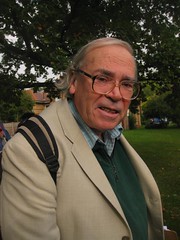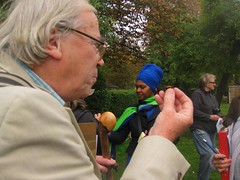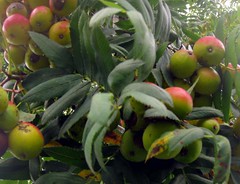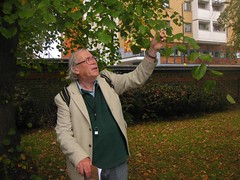Bowes and Bounds Connected
A Community Network for Bowes Park and Bounds Green
The mystery and magic of the trees of St Ann's Hospital
Last October, St Ann's hospital ran the first Tree Tour led by botanist David Bevan. This is my personal account of the tour:
Here's a little mystery for you history detectives to solve.
In the grounds of St Ann's Hospital are a large number of planted rare and interesting trees but nobody knows who was responsible for deciding the detail of the tree planting, remarkable for its wide variety and the amount of edible fruit trees selected. The only clue I can give you is that the planting was done in the 1920s. The organisers of Tuesday's tree tour would love to hear from you if you can unearth the answer.
Over 50 staff, service users and local people gathered in the grounds of the Hospital to listen to Haringey treasure, botanist David Bevan, give an entertaining and highly informative talk about the wonderful trees.

We began with the stars of the show, the twelve True Service trees. St Ann's has the finest True Service trees in North London (in fact you have to travel to the Wyre Forest to see better). It is an uncommon tree in Britain and wild trees are extremely difficult to find but there is a wild True Service tree in Railway Fields, the only one in London, which was probably seeded by a local bird.
The True Service has edible fruit which either resembles small apples or pears but it is not until the skin has turned a leathery brown and looks over ripe that the fruit is good to eat, in fact it is recommended to wait until the first frosts to harvest them. It tastes of a pear flavoured chocolate by the way.


It can be turned into an alcholic cider-like drink known as cerevisia to the Romans from which the name of the tree is thought to derive.
There are a number of Mulberry trees on the site. Some of the staff admitted that during the fruit season in July, lots of people can be seen dotted with the tell tale red stains of the Black Mulberry where they've been 'scrumping'
Another rarity for North London, was the Strawberry Tree. Although a native of the British Isles, you usually have to go to the West of Ireland to see it. The fruit is quite tart but those who tried it said it was rather nice.
There are also lots of crab apple trees which formed a sort of odd link with my encounter with the wartime table at Markfield Park where the art of making crab apple jelly was being demonstrated. We also found damsons, sweet chestnuts and lime trees, the young leaves of which make a good salad leaf.

There is a large patch of protected woodland at the back of the hospital backing onto the railway line, home to much local wildlife and native trees. David, in his time working at Haringey Council was responsible for getting the protection for this land as well as developing Railway Fields, so David has a special place in Harringay natural history.
Alas, I had to reluctantly drag myself away to pick up the small one from nursery but the rest of the party continued to explore. However, there will be more opportunities to learn about the trees. There are plans to do some tree conservation such as coppicing as well as harvest the fruit.
If you are interested in finding out more about the project you are welcome to email: info@treesofstanns.org.uk
Mobile number: 07973 733239.
The 'tree team' includes current and former mental health service users, and they particularly want to encourage local enthusiasts to be involved.
The next Tree Tour is on 19th January

Connecting the communities of Bowes Park and Bounds Green in north London.
Top Content
Translate this website
© 2025 Created by Richard McKeever.
Powered by
![]()
You need to be a member of Bowes and Bounds Connected to add comments!
Join Bowes and Bounds Connected